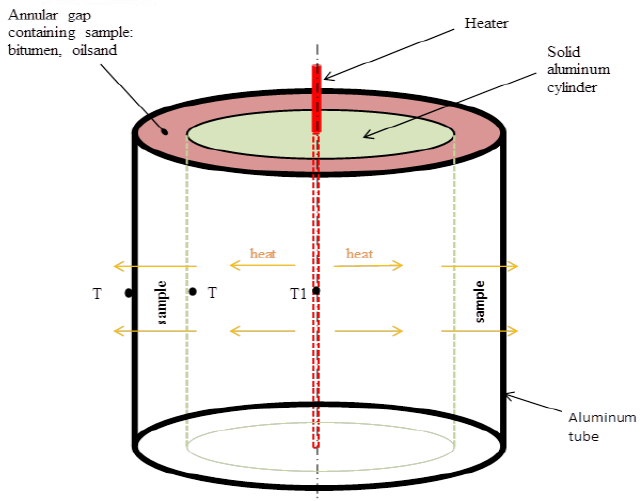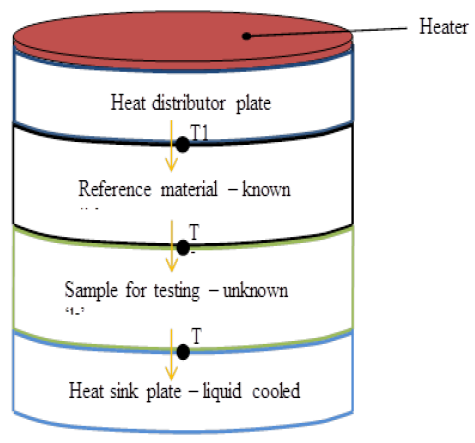Thermal Conductivity (Rock Core & Fluids)
PERM Builds Its Own Thermal Conductivity and Heat Capacity Measurement & Testing Devices for Unconsolidated Core and for Consolidated Core.
Method & Approach
PERM’s approach of study integrates steady-state physical experiments with computational modeling.
- Steady state measurement allows us to be extremely accurate.
- With the aid of scaled-up computational modelling, we are also able to properly quantify and exclude the presence of necessary foreign inclusions in the test apparatus (which is often the case when irregularly shaped core samples have to be modified to fit the test apparatus).
- We are also able to explore and discount the effects of other modes of heat transfer such as convection, which is often not the case in strictly physical measurement.
- All this is made possible through detailed modeling of the test arrangement, and matching the nodal temperatures obtained at steady state conditions with the test measurements.
Samples may be non-uniform or have irregular porous structure. We therefore propose the following three-step task approach:
- Conducting independent steady-state thermal conductivity measurements for the fluid components of the core system.
- Undertaking various steady-state physical tests and computations to ascertain thermal conductivity of core samples in saturated form.
- Carrying out supplementary tests with constituent sand packs filled with brine, or under vacuum to provide further data to ascertain rock-fluid mixing rules for the core system.
Radial Thermal Conductivity Description
- The radial system consists of a heat source in a central cylindrical disc, a tube installed concentrically to the central disc, and thermal probes arrayed collinearly in the vertical plane at various locations.
- Outside the tube is fluid circulated by a heating / cooling system, to keep temperature around the tube at a uniform value.
- In the measurement process, the test sample is transferred into the annular gap between the central cylindrical disc and the tube. A temperature gradient is established across the central disc and the bath fluid. Radial transfer of heat flux from the central heat source through the test sample, is assessed through the thermal probe measurements when temperature measurements attain steady-state conditions.
- The thermal conductivity of the test sample is then computed through analytical evaluations and matching with numerical simulations.
- Only fluid samples as well as non-consolidated core samples (such as shale and sand) are measured using this concept.
- The measurements can be made for varied uniform packs of non-consolidated core samples.
- Overall, measurements can be made for various temperature and pressure conditions. The temperature of measurement is the average fluid temperature, and the pressure also the average fluid pressure.
- We estimate the errors associated with the use of the radial system to be ~ 3% of the measurement.

Axial Thermal Conductivity Description
- A consolidated core sample of 10.1cm (i.e. 4”) diameter and no less than 2.5cm (i.e. 1”) is sandwiched between a reference material above the sample, and a heat sink plate below the sample cooled by a fluid.
- If the core sample to be tested is not of regular full cylindrical shape, there will be a need for filling up the unfilled portions of the cylinder with a material of comparably low thermal conductivity (e.g. Teflon). Nonetheless the packed cylindrical core will be CT-scanned, and accounted for by numerical simulations.
- Heat flux from a disc source is evenly distributed on top of the reference material. With such an arrangement compactly insulated to avoid any radial heat transfer out of the arrangement, heat from the source, is expected to be largely transferred axially.
- During the measurement process, a thermal gradient is initiated by the heat source and the heat sink, and established when steady-state conditions are reached. The temperature probes placed at central locations within the system are used to measure the heat flux, and deduce the thermal conductivity of the test sample numerically or analytically.
- Measurements can be made for various temperature and pressure conditions. The temperature of measurement is the average fluid temperature.
- We estimate the uncertainty limits for the use of the axial system to be no more than 5% of the measurement.

Modelling Thermal Conductivity
- Numerical modeling will be accomplished using COMSOL. COMSOL is a state-of-the-art simulation software environment used for modeling real-world engineering and scientific applications, including single and coupled phenomena.
- It utilizes a finite element analysis, provides a flexible interface for using in-built equations, or custom programming of equations. There is also the added utility of various preprocessing and post-processing of data.
- With all these utilities available in COMSOL, digitized images of core samples obtained through computerized tomographic (CT) axial scans and subsequent reconstruction using in-house codes, may be modeled to study coupled heat transfer and fluid flow phenomena, extract thermal conductivities, as well as assess convection and radiation heat transfers.
Summary of Thermal Conductivity Testing
- The system combines modelling and physical measurements.
- PERM has two different systems in order to measure consolidated core/rock material, unconsolidated core/rock material, and fluid samples.
- Everything is calibrated with materials and fluid with known thermal conductivities.
- For more details and to clarify any questions you may have, please get in touch with PERM to schedule a meeting.
